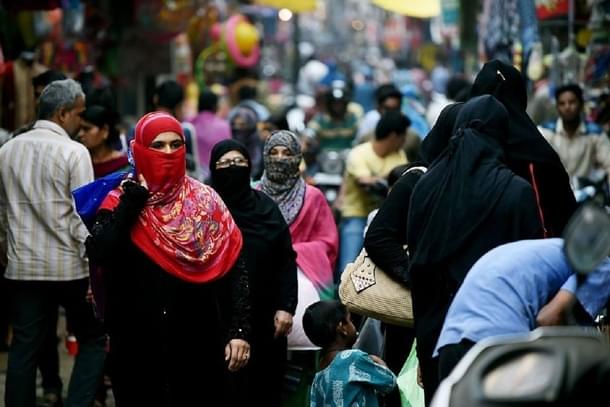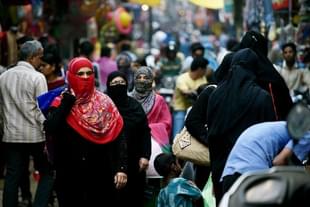Ideas
EAC-PM's Religious Demography Paper Should Not Be Buried In The Name Of Faux Secularism
R Jagannathan
May 13, 2024, 01:09 PM | Updated Aug 06, 2024, 12:41 PM IST
Save & read from anywhere!
Bookmark stories for easy access on any device or the Swarajya app.


In 'secular' India, many topics related to minorities are taboo. And three topics that are specifically off-limits are conversations around changes in religious demography, illegal immigration and conversions.
It is, therefore, no surprise that a working paper by Shamika Ravi, Abraham Jose and Apurv Kumar Mishra (the first-named author is a member of the Economic Advisory Council to the PM), on Share of Religious Minorities: A Cross-Country Analysis (1950-2015), has run into a barrage of unfair criticism from the usual suspects.
The report’s primary conclusion is that most countries are becoming more heterogeneous, with the population share of the majority population in 2015 showing clear, often strong, declines from 1950, while minorities showed steady, even destabilising, increases. (The details are given later, but you can access the full paper here).
Since in India, this would point to higher Muslim and Christian shares, the 'secular" lobby is apoplectic.
The Hindu, not known to be particularly concerned about Hindu welfare, called it a “Clickbait paper”. The Wire, which is fundamentally wired to painting only minorities as victims of Hindutva, did a fact-check, and decided that the paper is “Old data, New Spin”.
I agree with the claim that this paper does not necessarily bring us new data on India. But the global comparisons are noteworthy. Our own census data till 2011 showed much the same trends.
More than two decades ago, the Centre for Policy Studies (CPS) published an analysis by J K Bajaj, A P Joshi and M D Srinivas on the “Religious Demography of India” based on trends upto 2001. You can read more about post-2001 trends in the CPS blog here.
So, we have known for some time, over the last several decades, that the Hindu population in India has shrunk in terms of percentage share, while the Muslim population (and probably the Christian one too) has swelled.
What the 'secular' criticism reveals is a reluctance to discuss even what we already know, and they are effectively preventing a conversation based on facts.
Shamika Ravi and her co-authors come to several broad conclusions. Most of these conclusions are lifted straight from their paper. They are not my summations. But before we discuss the data, which has been drawn from the Religious Characteristics of States Dataset (RCS-Dem, 2017), here is their main conclusion:
“Our hypothesis is that the change in the proportion of the minority population as a share of total population is a good proxy for the status of minorities in a country over time. A society which provides a congenial environment for the flourishing of minorities is more likely to witness an increase or stabilisation in their numbers over a period of three generations. Conversely, a society which creates a hostile environment for minorities and/or denies them access to public goods and services is more likely to witness a decrease in their share of the overall total population.”
My point of disagreement is largely a quibble. Population shares can change for a variety of reasons, including poverty, immigration, and conversion, and hence a mere rise in a community’s population share need not indicate a “congenial environment” for it to flourish.
Communities under threat also can increase population shares (that is, if they cannot flee, as in Pakistan). However, we can reasonably conclude that the overall environment in India is not hostile to the growth and development of minorities, and that they face no existential threats.
My bigger concern is that the authors may have seriously underestimated (for no fault of theirs) the actual rise in the minority population in India, for Christians are probably undercounted.
Surveys and analyses published by Surendranath N in Swarajya suggest that wherever proselytisation has been aggressive, the census data is not entirely useful. Surendranath demonstrated this in the case of Andhra Pradesh (before bifurcation) and Tamil Nadu, both states in which the church is indirectly or directly supported by the state.
That said, let us look at their main conclusions, first globally, and next in the context of India and its neighbourhood:
One, “globally the share of the majority religious denomination(s) has gone down by approximately 22 percent. In other words, on an average the world has become more heterogeneous in the period under study.” This is absolutely right.
Two, “of the 40 countries that experienced the biggest changes, more than half are in Africa. Animism, as defined in the RCS-Dem Dataset, was the majority religious denomination in 24 countries in 1950. By 2015, it was no longer the majority in any of these countries.”
So what turned hostile for the majority religions in these countries? Clearly, the answer does not lie in any significant demographic changes or massive immigration. It can almost wholly be explained by religious proselytisation activities, most of them Christian.
Three, “Of the 94 countries that reported being Christian majority in 1950, 77 saw a decrease in the share of the majority religious denomination(s). In the same period, 25 out of the 38 countries that reported being Muslim majority, saw an increase in the share of the majority religious denomination.”
Conclusion: Christian majority countries do not pose an existential threat to minorities, but that is not something one can say about Muslim-majority countries. This implies that countries that see any dramatic rise in Muslim population shares should worry. South Asia has a problem.
Four, “In keeping with the global trends of declining majority, India too has witnessed a reduction in the share of the majority religious denomination(s) by 7.81 percent. This is particularly remarkable given the wider context within the South Asian neighbourhood, where the share of the majority religious denomination has increased and minority populations have shrunk alarmingly across countries like Bangladesh, Pakistan, Sri Lanka, Bhutan and Afghanistan.”
Further, “in Sri Lanka, the share of the majority Theravada Buddhist population increased by 5 percent while the share of Hindu population (the next largest religious group) declined by 5 percent. In Bhutan, the majority Tibetan Buddhist population increased by almost 18 percent while the Hindu population declined from 23 percent to 11 percent in the same period.”
The interesting pointer here is that even small, Buddhist-majority countries may not be particularly mindful about their minorities.
Five, “Among non-Muslim majority countries, Myanmar, India and Nepal saw a decline in the share of the majority religious denomination(s). Myanmar witnessed the steepest decline of the majority religious group in the region with the share of (the) Theravada Buddhist population declining by 10 percent in the period under study. Of the three major religions in Nepal, the share of the majority Hindu population declined by 4 percent, the share of the Buddhist population declined by 3 percent while the Muslim population increased by 2 percent.”
Myanmar is the contrasting country here, since both India and Nepal are Hindu majority while Myanmar is Buddhist. One must check if this Buddhist decline is related to the civil wars going on in various parts of Myanmar, or due to some other factors. The Buddhist clergy, for their part, has been intolerant of the Rohingya Muslims, many of whom have been driven out.
My own conclusions, based not only on Shamika Ravi & Co’s working paper, but also other sources of information, are the following:
First, religious demography matters. The fact that Hindus and other minorities are badly treated in the neighbourhood, and face an existential threat, is something that cannot be ignored.
We probably need much stronger laws than just the Citizenship Amendment Act, which gives only a handful of the persecuted minorities in the neighbourhood an accelerated path to citizenship.
Second, the right geographical unit from which to draw religious demographic conclusions is the district, as Sreemoy Talukdar correctly argues in a recent Firstpost article based on Shamika Ravi’s other work on district-wise religious demography changes published in the Economic & Political Weekly (the article is paywalled).
This is for two reasons: one, each Indian district is, on an average, bigger than over 80 countries in terms of population. And two, even at the state level, Hindus are minorities in eight states or Union Territories (J&K, Ladakh, Punjab, Lakshadweep, Nagaland, Mizoram, Meghalaya, and Arunachal Pradesh). But they don’t get treated as minorities.
In J&K, the minority Hindus were driven out of the valley but the world has refused to take note. The narrative is still about the larger Indian role in “minority-dominated Kashmir”, when Muslims are definitely not the minority in J&K.
Even though court judgements have held the state as the basic unit for deciding majority and minorities, the minority status of Hindus is not recognised in many states. If the unit is the district, the number of Hindu minority areas would rise significantly.
Third, conversions and immigration trends matter. We have shown this with Andhra Pradesh and Tamil Nadu, where Christians are undercounted, and hence Shamika Ravi’s totals involve a serious undercount of minority populations.
In Assam, parts of West Bengal and Bihar, illegal immigration from Bangladesh has probably tilted the demography even more against Hindus, but the sizable numbers of Muslims ensures that this issue will never be discussed in 'secular' circles.
Even though illegal migrations also include Hindu refugees from Bangladesh, no one has chosen to ask why the corresponding Hindu population shares in Assam and West Bengal do not seem to have risen. There is wilful blindness to adverse changes to Hindu demography, as I have noted before in articles in Swarajya.
The argument, that Muslim birth rates are falling and converging with Hindu rates, is not very relevant, for what matters is how a religious community behaves in a specific context, and not just its overall share in population. India was divided on religious lines when the Muslim population share was far below 30 per cent of the total in 1947.
Much smaller Muslim populations in Europe are destabilising its societies, and a much larger proportion in post-partition India, taken together with aggressive conversions to Christianity, can neither be wished away nor forever be kept out of conversations. If minority sentiments matter, so do majority sentiments.
Shamika Ravi & Co have forced us to talk about these issues, and it is high time we did so without letting political correctness come in the way. It will not be an easy conversation, but it needs to happen and not dismissed with shrill allegations of 'communalism' or 'Islamophobia'.
Jagannathan is former Editorial Director, Swarajya. He tweets at @TheJaggi.





